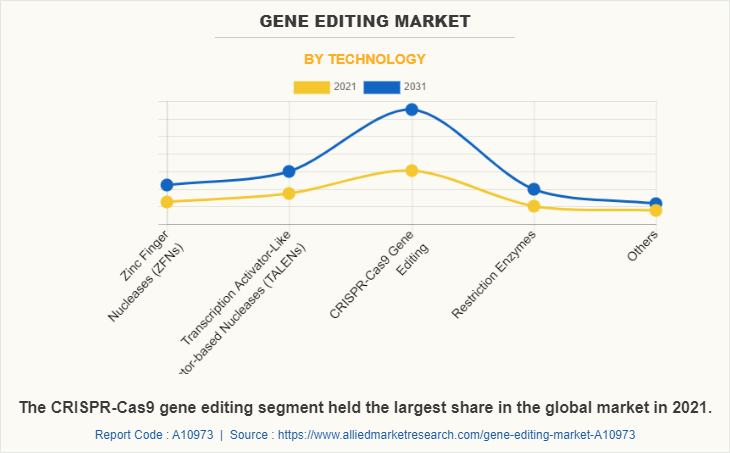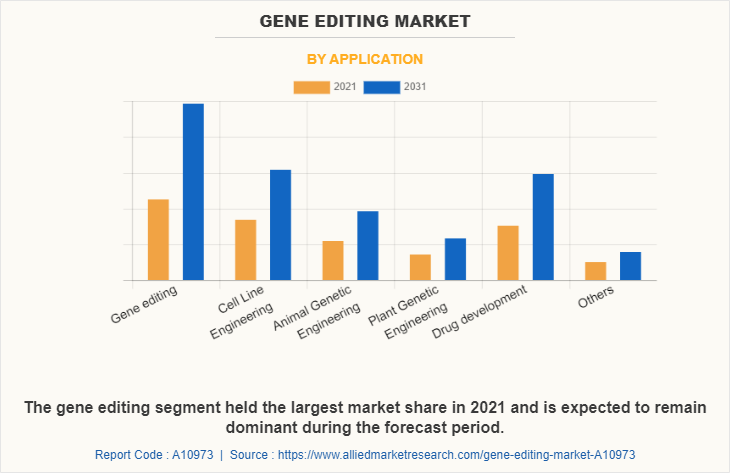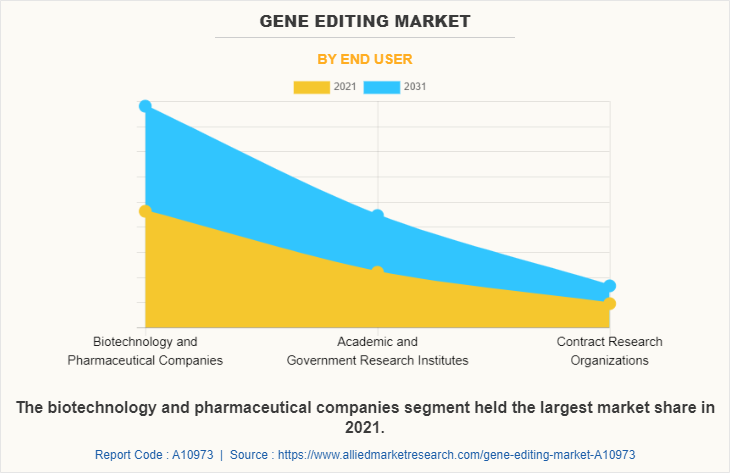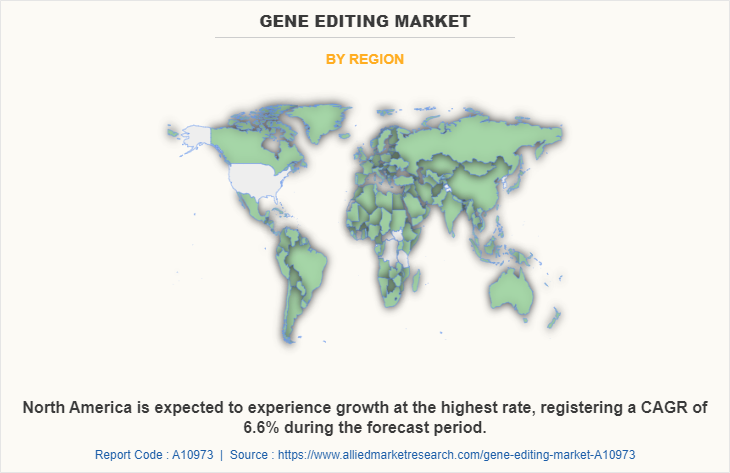Gene Editing Market Statistics
The global gene editing market was valued at $3.9 billion in 2021, and is projected to reach $7.4 billion by 2031, growing at a CAGR of 6.7% from 2022 to 2031. The growth of market is driven by rise in demand for synthetic genes in both developed and developing countries. The identification of human genetic abnormalities, drug discovery, agriculture, veterinary sciences, and forensics are all areas where genomics can be used. With the introduction of next generation sequencing, the use of genomics in forensic investigations has risen substantially, owing to tools developed specifically for forensic science by Illumina (US). NGS aids in the study of a specimen at the scene of a crime and allows the extraction of bigger amounts of information from a trace or a damaged DNA sample, whereas DNA analysis was previously employed for fingerprint profiling.
Future genomic engineering trends include applications in marine engineering, such as the creation of nutraceuticals from algae. Other emerging use areas include, forensic sciences and tailored medicine. During the assessment of fish populations, NGS can be utilized for DNA barcoding to identify fish larvae and eggs, as well as a thorough description of fish communities. The use of genomics in food quality and safety testing is becoming more common. Drug development, as well as the diagnosis and treatment of human genetic abnormalities, rely heavily on genome editing technology. NGS, DNA analysis and profiling, and plant and animal genetic engineering all use genome editing.

Gene editing (also known as genome editing) refers to a set of technologies that allow scientists to alter an organism's DNA. These technologies allow for the addition, removal, or modification of genetic material at specific points in the genome. There have been several ways to genome editing developed. In the prevention and treatment of human diseases, genome editing is of tremendous interest. The majority of genome editing research is now conducted utilizing cells and animal models to better understand illnesses. Scientists are still trying to figure out if this method is safe and successful in humans. It is being studied for a number of ailments, including single-gene disorders including cystic fibrosis, hemophilia, and sickle cell anemia. It also has the potential to treat and prevent more complex ailments like cancer, heart disease, mental illness, and HIV infection. This technology is mostly used to make genetically modified crops more accessible by delivering gene editing reagents to the plants.
Furthermore, this method can be used to create genetically modified animals to be used in agricultural and biomedical industries. Gene editing, also known as genome editing, is a technique for altering an organism's DNA using a variety of methods. This approach allows for the replacement, addition, or removal of genetic material at spotted places in the genome. As a result, a variety of editing techniques have been created for use in the industry. Human disorders such as cystic fibrosis, sickle cell disease, HIV infection, cancer, and others are also treated and prevented through gene editing.
Applications in marine engineering, such as the generation of nutraceuticals from algae, are among the future genomic engineering trends. Forensic sciences and customized medicine are two more new areas of use. NGS can be used for DNA barcoding to identify fish larvae and eggs, as well as a detailed description of fish communities, when assessing fish populations. Genomic testing for food quality and safety is becoming more widespread. Genome editing technology is used extensively in drug development, as well as in the identification and treatment of human genetic disorders. Genome editing is used in NGS, DNA analysis and profiling, and plant and animal genetic engineering. In emerging economies, synthetic genes are better suitable for the development of genetically modified (GM) crops. Plants native metabolic pathways are modified by synthetic genes to improve photosynthetic efficiency and nutritional quality.
Moreover, off-target effects from CRISPR-Cas9 are a big problem. Any off-target nuclease activity can result in changes in these genes, potentially leading to cancer because Cas9 causes double-stranded breaks. CRISPR-Cas9 can tolerate one to three mismatches in its target, which can result in nuclease activity that is off-target. Furthermore, the high rate of off-target activity (50 percent) mutations in locations other than the targeted on-target location, is a major source of worry. CRISPR can, for example, target a tumor suppressor gene or activate a cancer-causing gene. This unfavorable consequence has caused problems for many companies preparing clinical studies.
Clinical trials have been halted, and regulatory officials are demanding more research to improve the method's safety. Researchers prefer the CRISPR/Cas9 technology for producing and editing novel crops in this case. For the production of genetically modified crops, this technology also necessitates many regulatory approvals.
Emerging markets, such as the BRICS countries, are likely to provide considerable potential for the genome editing business to grow. This can be ascribed to these countries' increasing R&D expenditure for various research groups. Brazil, is a global leader in industrial biotechnology research and investment, particularly in cellulosic sugars and agribusiness. Brazilian biotechnology firms are concentrating on the creation of new pharmaceuticals (small molecules and biologics), diagnostics, vaccines, cell treatments, regenerative medicine and tissue engineering, and genetic and molecular testing.
In light of these trends, top players in the genome editing market are focusing on inorganic tactics including partnerships and collaborations to extend their distribution networks and improve their manufacturing capabilities in Brazil and other emerging markets which is boosting the gene editing market size. Furthermore, rise in demand for synthetic genes for medicine development to cure cancer are expected to enhance the gene editing market share significantly in the future years.
Impact of COVID-19 on Gene Editing Market
The World Health Organization (WHO) on January 30, 2021 declared COVID-19 as a pandemic and general wellbeing crisis of international concern. COVID-19 has impacted around 210 countries across the globe, owing to the COVID-19 pandemic. State-run administrations across the globe declared inescapable lockdowns as well as social distancing measures to forestall breakdown of the healthcare structure. States have additionally given constraints and preventions on undertakings and elective surgeries. These obstructions continue to influence the growth of different industries and the enhanced response toward these regulations affects the industry. The distribution, production, and store network have been impacted, due to lockdowns across the globe.
Similarly, the gene editing market had a positive impact during the pandemic, owing to social distancing norms and least availability of hospital beds prompted for maximum adaptation of home-based patient care system. COVID-19 has altered the way we live. It has also increased the scientific community's already rapid tendencies in invention and collaboration. Researchers are scrambling to discover diagnoses, vaccines, and therapies as the pandemic spreads around the world. In the search for new ways to combat SARS-CoV-2, the novel coronavirus that causes Covid-19, researchers have turned to machine learning, artificial intelligence, and high-throughput experimental automation.
CRISPR is another effective method they are employing to speed up the process. This gene-targeting and gene-editing technology, which is based on a mechanism used by bacteria to fight viruses naturally, is already proving effective in our joint fight against this new virus. Isolating infected patients and monitoring proper healthcare responses require the SARS-CoV-2. Hence, the COVID-19 pandemic had a positive impact on the gene editing market.
Gene Editing Market Segmentation
The gene editing market size is segmented on the basis of technology, application, end user, and region. By technology, the market is bifurcated into zinc finger nucleases (ZFNs), transcription activator-like effector-based nucleases (TALENs), CRISPR-Cas9 gene editing, restriction enzymes, and others. The others segment is further classified into homing endonucleases or meganucleases and antisense technology. By application, the market is segmented into gene editing, cell line engineering, animal genetic engineering, plant genetic engineering, drug development, and others. The others segment is further classified into bioenergy, diagnosis, cell and gene therapies, microorganisms genetic engineering, drug discovery, gmo, vaccine development, and basic research. By end user, the market is fragmented into biotechnology & pharmaceutical companies, academic & government research institutes, and contract research organizations.
By Technology
By technology type, the CRISPR-Cas9 gene editing segment was the highest revenue contributor to the gene ediing market, with $1,522.25 million in 2021, and is estimated to reach $3,254.24 million by 2031, with a CAGR of 7.9%. The transcription activator-like effector-based nucleases (TALENs) segment is estimated to reach $1,498.29 million by 2031, at a significant CAGR of 5.5% during the forecast period. The CRISPR-Cas9 gene editing and transcription activator-like effector-based nucleases (TALENs) segments collectively accounted for around 61.58% market share in 2021, with the former constituting around 39.17% share.
The CRISPR-Cas9 gene editing and restriction enzymes segments are expected to witness considerable CAGRs of 7.9% and 7.0%, respectively, during the forecast period. The cumulative share of these two segments was 51.98% in 2021 and is anticipated to reach 56.96% by 2031.

By Application
By application type, the gene editing segment was the highest revenue contributor to the market, with $1,123.16 million in 2021, and is estimated to reach $2,466.29 million by 2031, with a CAGR of 8.2%. The cell line engineering segment is estimated to reach $1,546.28 million by 2031, at a significant CAGR of 6.2% during the forecast period. The gene editing and cell line engineering segments collectively accounted for around 50.57% gene editing market share in 2021, with the former constituting around 28.9% share. The gene editing and drug development segments are expected to witness considerable CAGRs of 8.2% and 6.9%, respectively, during the forecast period. The cumulative share of these two segments was 48.5% in 2021 and is anticipated to reach 53.08% by 2031.

By End User
By end user, the biotechnology and pharmaceutical companies segment was the highest revenue contributor to the market, with $2,311.49 million in 2021, and is estimated to reach $4,394.71 million by 2031, with a CAGR of 6.6%. The academic and government research institutes segment is estimated to reach $2,216.86 million by 2031, at a significant CAGR of 7.2% during gene editing market forecast. The biotechnology and pharmaceutical companies and academic and government research institutes segments collectively accounted for around 87.8% market share in 2021, with the former constituting around 59.48% share.
The academic and government research institutes and biotechnology and pharmaceutical companies segments are expected to witness considerable CAGRs of 7.2% and 6.6%, respectively, during the forecast period. The cumulative share of these two segments was 87.8% in 2021 and is anticipated to reach 88.9% by 2031.

By Region
Region wise, in gene editing industry, North America was the highest revenue contributor, accounting for $1,723.2 million in 2021, and is estimated to reach $3,279.18 million by 2031, with a CAGR of 6.6%. Europe is estimated to reach $1,822.18 million by 2031, at a significant CAGR of 5.8%. North America and Europe collectively accounted for around 70.84% share in 2021, with the former constituting around 44.34% share. Asia-Pacific and LAMEA are expected to witness considerable CAGRs of 7.7% and 7.0%, respectively, during the forecast period. The cumulative share of these two regions was 29.16% in 2021 and is anticipated to reach 31.41% by 2031.

Major key players that operate in the gene editing industry are Addgene, Allele Biotech, Bio-Rad Laboratories, CRISPR Therapeutics, General Electric, OriGene Technologies, Precision Biosciences, Takara Biotech, Thermofischer Scientific Inc., and Transposagen Biopharma Inc.
Key Benefits for Stakeholders
- This report provides a quantitative analysis of the market segments, current trends, estimations, and dynamics of the market from 2021 to 2031 to identify the prevailing gene editing market opportunity.
- The market research is offered along with information related to key drivers, restraints, and opportunities.
- Porter's five forces analysis highlights the potency of buyers and suppliers to enable stakeholders make profit-oriented business decisions and strengthen their supplier-buyer network.
- In-depth analysis of the gene editing market segmentation assists to determine the prevailing market opportunities.
- Major countries in each region are mapped according to their revenue contribution to the global market.
- Market player positioning facilitates benchmarking and provides a clear understanding of the present position of the market players.
- The report includes the analysis of the regional as well as global gene editing market trends, key players, market segments, application areas, and market growth strategies.
Gene Editing Market Report Highlights
| Aspects | Details |
| By Technology |
|
| By Application |
|
| By End User |
|
| By Region |
|
| Key Market Players | CRISPR Therapeutics, Merck KGaA, OriGene Technologies, Precision Biosciences, Addgene, Takara Bio, ThermoFischer Scientific Inc., Bio-Rad, GE Healthcare, Allele Biotech |
| Other Players | GeneCopoeia |
Analyst Review
Genome editing tools allow scientists to alter DNA, resulting in changes in physical characteristics, such as eye color and illness risk, to achieve which, scientists employ a variety of technologies. Gene editing tools are molecular devices, which work like scissors that cut DNA at a precise location. The DNA that was cut can then be removed, added to, or replaced by scientists. The first genome editing tools were developed in late 1900s. More recently, a new genome editing technique known as CRISPR, which was developed in 2009, made modifying DNA easier than ever before. CRISPR is easier, faster, less expensive, and more precise than previous genome editing technologies. CRISPR is being used by many scientists that do genome editing.
Factors such as increase in adoption of CRISPR genome editing technology along with expanding synthetic gene demand in various biotechnology areas has fueled the growth of the gene editing market. Furthermore, due to the growing uses of genome editing technologies, the industry is seeing rise in competition among market competitors. The highly flexible CRISPR technique has gotten a lot of attention lately. For example, Vertex Pharmaceuticals paid CRISPR Therapeutics $900 million in April 2021 to develop, manufacture, and market CRISPR-Cas9 gene-edited treatment for beta-thalassemia and sickle-cell disease. Market growth is expected to be aided by such activities. Furthermore, the industry is being driven by the development of CRISPR-based innovative diagnostic tools to alleviate the negative effects of the COVID-19 pandemic.
In addition, North America accounted for the largest share of the gene editing market, which is attributed to surge in cancer, cardiovascular disorders, and the escalating demand for synthetic gene within the region.
The total market value of gene editing market is $3,886.34 million in 2021.
The forecast period for gene editing market is 2022 to 2031
The market value of gene editing market in 2021 is $7,437.47 million.
The base year is 2021 in gene editing market
Top companies such as Crispr Therapeutics, Takara Bio, Origene Technologies, Addgene, Thermofischer Scientific Inc., and Precision Biosciences held a high market position.
The CRISPR-Cas9 segment is the most influencing segment owing to its application for drug discovery and identifying cancer market.
Increase in adoption of CRISPR genome editing technology along with expanding synthetic gene demand in various biotechnology areas has fueled the growth of the gene editing market. FurtherThe highly flexible CRISPR technique has gotten a lot of attention lately.
Loading Table Of Content...



